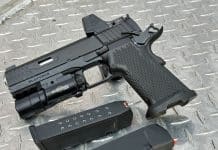[dcs_img_right
framed=”black” w=”220″ h=”220″]
http://gunsandtactics.wpengine.com/wp-content/uploads/2012/02/imi_logo.jpg
[/dcs_img_right]
Israel faces an unusual set of circumstances when it comes to national defense. Though it spent the first 25 years of its existence surrounded by enemies, it does have a significant strategic advantage that’s not always obvious: Thanks to its small size, it has short internal lines of communication and can shift forces quickly and easily from one border region to another. Against multiple but uncoordinated adversaries, as in the 1973 and particularly the 1967 war, it can employ the bulk of its forces against one opponent at a time to defeat them piecemeal.
Though it used a mixture of British, French, and American tanks for two decades, in the 1960s the Israeli Defense Force decided to develop a domestic main battle tank (MBT). What resulted, debuting in 1978 after five years of development, was the Merkava (Hebrew for chariot). Its design has features that adapt it to the predominantly defensive operations that have characterized many of Israel’s wars. Unlike most MBTs, the Merkava has a troop compartment in the rear, something accomplished by placing the engine compartment in the forward portion of the hull. The rear hatch access allows this space to also be utilized as a first aid station or command post with safe entry and exit under fire if the Merkava is parked in an emplacement during defensive operations. Alternately, the tank can carry up to eight troops or three litters in mobile operations. Placing the engine in the front also adds a layer of protection for the four-man crew—an important consideration for a small nation that cannot easily replace large numbers of casualties.
[dcs_chain_gallery number=”5″ gid=”14″ desc=”true”
name=”false” float=”right” tw=”36″ th=”36″ w=”300″
margin=”4px 0px 15px 15px”]
The Merkava has since gone through multiple variants. Lessons learned in the 1982 Lebanon War, which was the Mark I’s first combat employment, led to a variety of improvements and upgrades introduced in April 1983 with the Mark II. One important one was the discovery of a weakness—that a properly-placed hit along the rear of the turret ring could jam the turret—which was mitigated with a metal skirt designed to pre-detonate rocket-propelled grenades and anti-tank rockets. Optical and fire control system upgrades were made with the IIB variant and armor improvements marked the IIC and IID models.
The Mark III variant entered service in December 1989 and was the first model to switch to the 120mm main gun from the 105mm version on the Mark I and Mark II. A series of communications, armor and survivability, and NBC (nuclear, biological, and chemical) protection upgrades marked the Mark III BAZ and Mark III Dor-Dalet (“Fourth Generation”) models.
The current version, the Merkava Mark IV, entered service in late 2004. Like its predecessors, it incorporates a 60mm mortar (remotely controlled since the Mark II model) with a range of 2,700 meters in addition to the main gun and 7.62mm machine guns. It is protected by composite and modular armor, the LWS-2 laser warning system which is linked to two launchers on the turret equipped with decoys and smoke grenades, and the Rafael Trophy Active Protection System. Trophy uses radar sensors to provide all-around detection, tracking, and interception of anti-tank rockets and missiles and tank high-explosive anti-tank (HEAT) rounds. The system was combat-tested in early 2011 when it protected a Merkava 4 of the 401st Armored Brigade from an anti-tank missile in the Gaza Strip.
The new fire control system is a highly capable, fire-on-the-move system which can even track a helicopter in flight.
It includes components standard on advanced Western tanks such as dual-axis stabilization, thermal imaging, and a laser rangefinder. The communications system is capable of the advanced data handling required by current battlefield management systems.
The Merkava line has seen continual improvements in power-to-weight ratios. The Mark I had a 900-hp engine which was retained in the Mark II but upgraded to a 1,200-hp plant in the Mark III. The Mark IV boasts a 1,500-hp engine with only a minor increase in vehicle weight.
A very capable tank on its own merits, the Merkava 4 is even more impressive when considered in the tactical environment for which it was born and bred: Israel and its surroundings. This variant will easily take the Israeli Defense Force well into the 21st century.













very good article … thank you
Excellent article, It answered several questions I had about the tank.
Comments are closed.